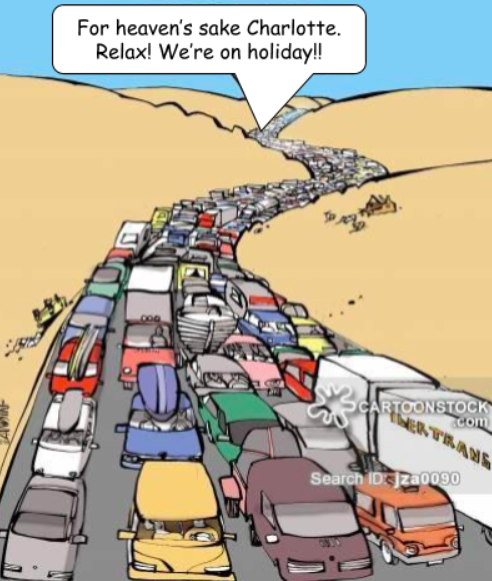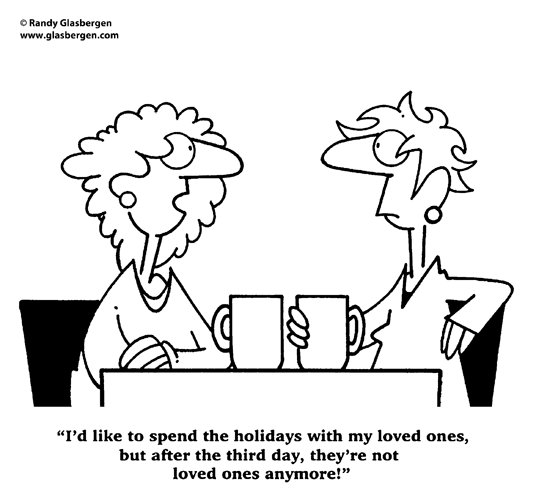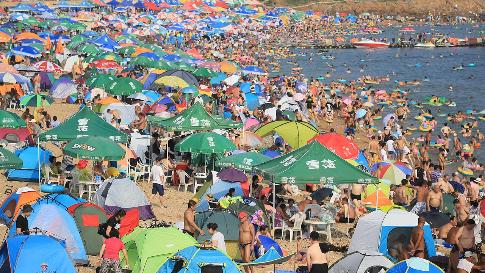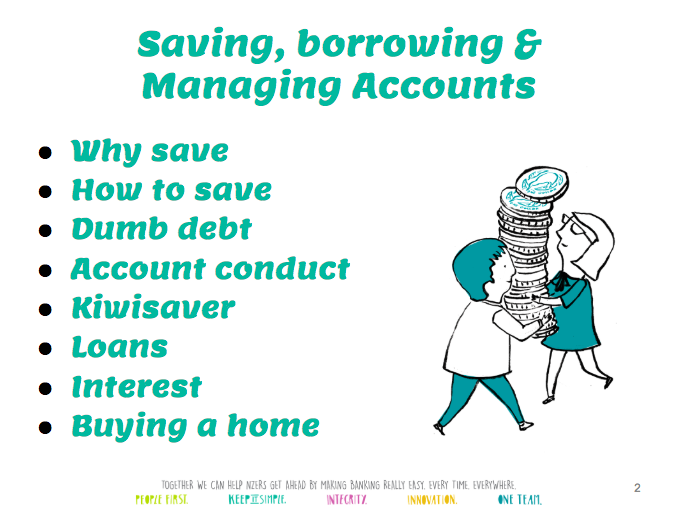10 Business Studies 3
Section outline
-
CONTENTS- Team building
- Entrepreneurs
- Types of Business
- Markets & segmentation
- Market Research
- Marketing Mix - Product, Price, Place, Promotion
- NCEA 1.4 Marketing Mix
- The role of markets - houses, shares, commodities
- Economics
- Business Issues, goals and stakeholders
- Finance & Accounting
- Market Day - putting it all together
- Web text - Wikibooks GCSE Business Studies
-
Hi everyone,
Please email me at isuckling@mhjc.school.nz if you have questions about any part of the course.
Alternatively, you can find me in Mountains Whanau any time.Mr Suckling :)
We're guided by the NZ Curriculum:
Level 5
Understand how economic decisions impact on people, communities, and nations.
Understand how people’s management of resources impacts on environmental and social sustainability.
Understand how people seek and have sought economic growth through business, enterprise, and innovation.Level 6
Understand how, as a result of scarcity, consumers, producers, and government make choices that affect NZ society.We're also guided by the Themes for Business NCEA Level 1. Topics we'll cover are:
Business formation- describe the different types of business and explain their advantages and disadvantages
- describe the importance of market research
- describe the marketing mix in relation to a target market
- describe the role and skills of the entrepreneur.
- outline the importance of business aims and objectives
- outline why businesses keep financial records
- outline the cash flow cycle (including budgets)
- define different types of business success.
- outline how and why business contributes to the development and well being of society
- identify the stakeholders of a business
- identify sustainable (environmental) business expectations and practices
- describe the competition in the local business environment
-
Team Building
Learning Intentions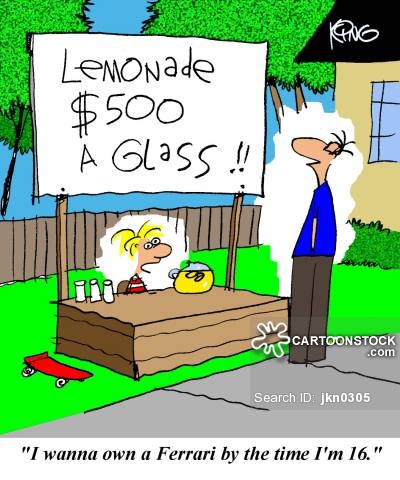
- Start to 'Form' our class as a team
- Build relationships (learn names, backgrounds, etc)
- Discover our Business 'prior knowledge'
- We have worked together to complete a task
- We found things that we have in common
- We know the meaning of common business terms
- In small groups of students representing at least 3 Whanau, click this link and complete the crossword.
Homework- Think about what stage our class team is at - here's a simple resource on 'Stages of Team Formation'
- Contribute to the shared Google Doc in Google Classroom called 'Building a Team'. This link may work.
- The doc asks you to add a photo of something that represents who you are as a person (eg you might be adventurous, home loving, or sporty).
- It asks you to give some information about yourself (a strength or skill that you're proud of, why you chose Business Studies, an embarrassing moment, etc.
- Start to 'Form' our class as a team
-
Entrepreneurs

Learning Intentions
- Study case studies of entrepreneurial people
- Investigate the nature of entrepreneurs.
- Explore business purpose/goals/types/examples
- Research pros & cons of business activities (eg multi-national, limited liability)
- We can define an entrepreneur and describe the attributes of an entrepreneur
- We can identify people with entrepreneurial attributes and name examples of entrepreneurial people
- We have identified our own entrepreneurial strengths and areas to develop
- We have started a glossary of business terms
- We can explain the nature of business and its pros & cons.
Do Now - Entrepreneurs- Remain in your small groups of at least 3 Whanau. Spend 3 minutes sharing what you know about 'entrepreneurs'. Then read the following notes and web resources. Share what you've learned that you didn't know before. Discuss whether you think you could be an entrepreneur and why.
Notes
An entrepreneur has an idea and risks time, money and reputation putting the idea into action as a business.Entrepreneurs are innovative. They:
- Have ideas AND can put them into action
- Are creative problem solvers (think outside the box)
- Work long hours
- Can sell and / or build
- Can simplify processes and data - identify what's important
- Are effective with people
Whole Class Activity
- As a whole class, we'll watch the video "Caine's Arcade Part 1"
- Each small group choose a different attribute from the list of 6 above
- Go to Google Classroom and, in the Doc called "Entrepreneurs", type things that Caine says or does that shows that he has your chosen attribute?
Small Group Activity- As a whole class, we'll watch the video "Stupid ideas - Dragon's Den"
- In your small group, discuss whether you think Rupert Evans is an entrepreneur and in which of the 6 attributes he is weakest.
Homework
- Watch the video Caine’s Arcade Part 2.
- Individually in the GDoc called "Entrepreneurs", share whether you think Nirvan Mullick (Caine’s first customer) is an entrepreneur and explain why.
Extra Case Study
- In the GDoc called "Entrepreneurs", are resources on Jordan Daykin who, at 18, was the youngest participant on Dragon's Den 2014. He quickly became a multi millionaire. Read and watch the resources.
- In the GDoc called "Entrepreneurs", are resources on Youtube millionaires. Read the articles and discuss as a group if these people are entrepreneurs. What could your Youtube channel focus on?
- Eastern Courier, 12 Feb 2020 - local example of an idea put into practice.
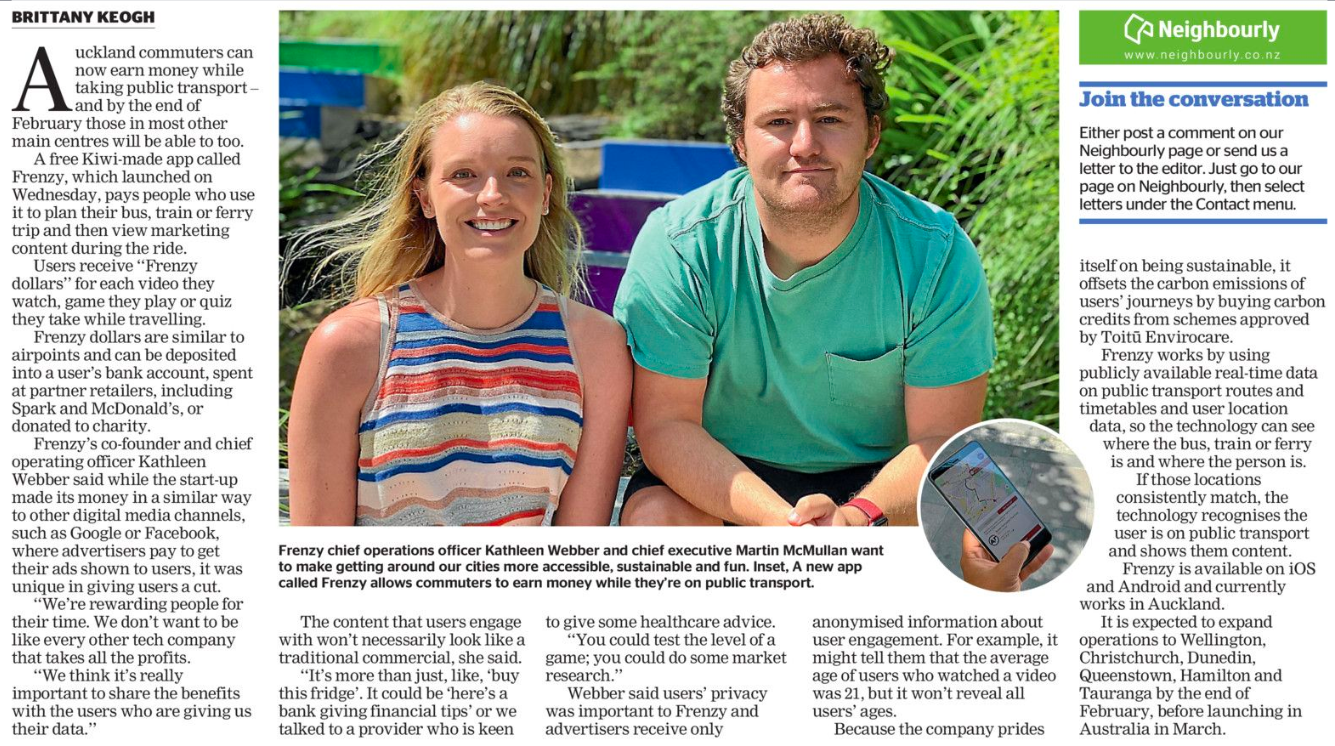
-
Business
- Do Now - Businesses

- Study the resource showing the world's top 100 economies. Discuss how this affects you as a NZ resident.
- The world’s top 100 economies: 31 countries; 69 corporations (World Bank, Duncan Green, 2016)
Small Group Activity- In your small group, choose a topic from the list below; research it and then type notes in the GClassroom Doc called "Businesses".
- You will present your findings to the whole class. The topics are:
- Soletrader - what is it, pros & cons and examples
- Partnership - what is it, pros & cons and examples
- Company - what is it, pros and examples
- Company - what is it, cons and examples
- Limited Liability - what is it and pros & cons (for the business and for us)
- Public vs private companies and Directors vs shareholders - define each.
- Here's a resource that may help https://www.shopify.co.nz/guides/new-zealand/business-structures
-
Markets & Segmentation
Learning Intentions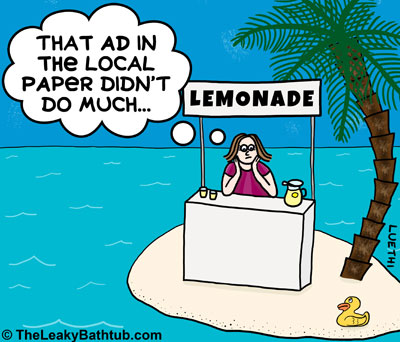
- Study case studies of markets and marketing
- Investigate the nature of marketing: Plan, Strategy and Segmentation.
- We can define and explain Markets
- We can describe how & why markets are segmented
- We have added to the glossary of business terms
Markets- A Market is a way in which buyers and sellers exchange goods or services. It can be a physical marketplace like a bazaar or shopping centre, or a virtual, online market (eg share or money market, Trade Me, eBay). Resource on markets
- Maeklong Market in Thailand has hundreds of small vendors using identical stands with identical shade awnings, selling identical products. Many sell the same types of fresh fish, others the same types of vegetables, and others the same cooked food.
Do Now - Markets
- As a class we'll watch the video clip of the market. Discuss the following questions and then answer them individually in the Google Doc called Markets, Segmentation and Research:
- As a customer, why might you choose to buy from one stall, rather than others, when so much is identical?
- If you were a vendor in the market, would you be able to lower your prices? What might happen if you did?
- Would you be able to make your products be, or appear to be, different? If so, how?
- How could, or how do, vendors promote their products?
- Are there ways vendors at the market might try to vary the place where they exchange their products with customers? A clue is to think how Pizza shops and supermarkets are trying this in NZ.
Market Segments
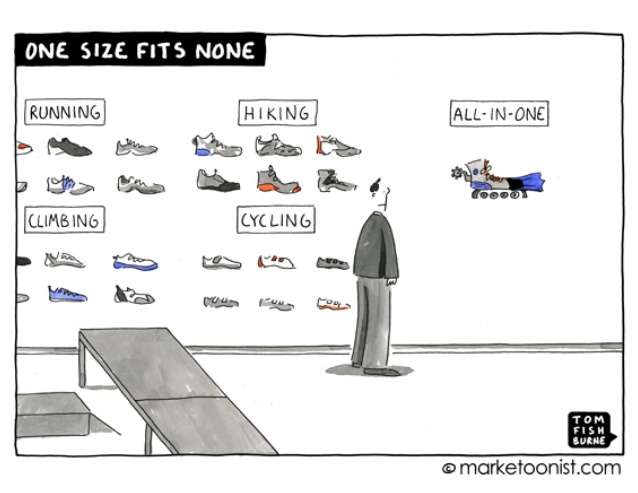
A Market Segment is a group of individuals with similar characteristics, eg Generation Z, retired couples, teenage girls, DINKYS.
For example, markets can be segmented by gender, age & life-cycle stage, socio-economics, ethnicity, lifestyle / family type, location, product use.
By segmenting the market, businesses can more accurately meet the needs of their target market. They can offer variations of their product that make the consumer think one variation is specifically designed for them and so they are willing to pay a higher price.
Do Now
Toothpaste is toothpaste, right? Wrong - at least, not in the Marketing Department. In small groups, discuss the different types of toothpaste available in the shops. This Countdown online shopping site might help. Individually answer the questions in the Google Doc called Markets, Segmentation and Research.
- Study case studies of markets and marketing
-
Market Research
Learning Intentions
- Investigate the meaning and examples of research-related terms
- Explore how and why companies gather information on us as consumers
- Can define and explain, with examples, market research-related terms
- Am aware of how companies gather information about my buying habits.
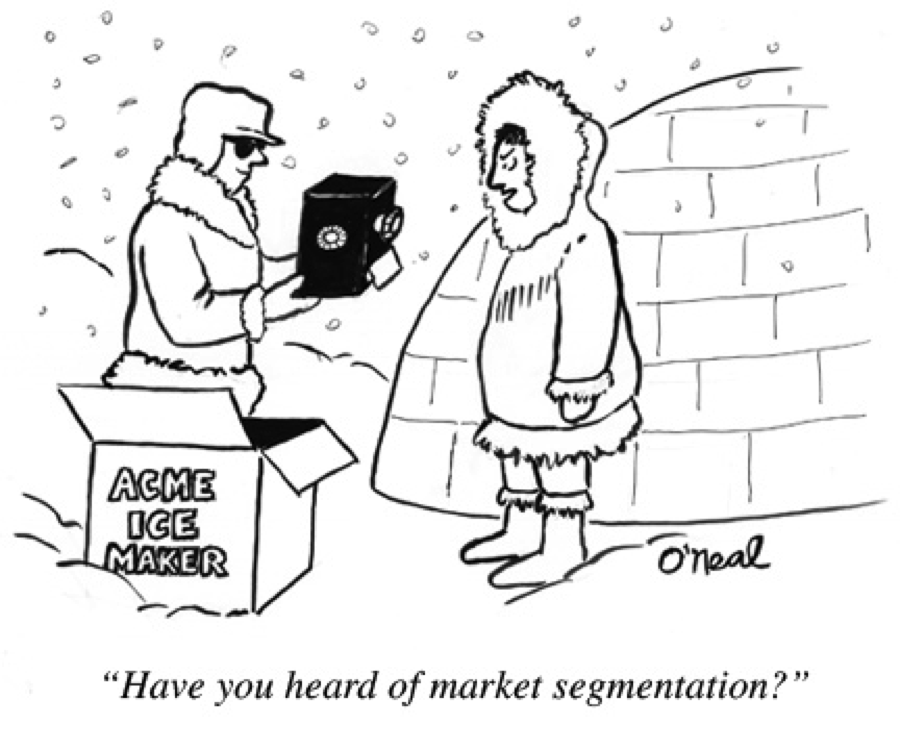 Make your own notes on Market Research in the Google Doc called "Markets & Market Research"(in Google Classroom). Later in the year, you will perform some market research before trading products at a Market Day.
Make your own notes on Market Research in the Google Doc called "Markets & Market Research"(in Google Classroom). Later in the year, you will perform some market research before trading products at a Market Day.Words that you need to include in your notes are:
- Qualitative & Quantitative information
- Primary & Secondary research (with examples of each)
- Sample size
- Closed & open questions
- The difference between a survey and a questionnaire
- Facebook have just been threatened with a fine in Belgium for doing something to do with gathering data on people - describe what.
- Supermarkets and other shops have loyalty cards - explain why this is relevant to market research?
- Describe other ways that companies find out about your buying habits?
- Facebook loses privacy case, faces fine of up to $125,000 million
- 6 ways retailers track your spending habits
- Tracking customers will be the norm
- Technologies to track people
Researching consumers of bottled water
We'll spend a week designing and performing research into consumers' attitudes, beliefs and preferences on bottled water brands.
Nine brands of bottled water, each with different labels, packaging (bottle shape, size, colour and material), and brand images.
Will the most expensive be perceived as the best and will consumers think it tastes the best?
When the product (water) is essentially identical in each bottle, do consumers see each bottle as having identical value? What role do non-price factors play in influencing consumers' perceptions? Are their perceptions real?
-
Here's a Google Slide show that summarises this term's Marketing work:
https://docs.google.com/presentation/d/14UDSU13iyh4UQYQb0U7D9PYsvmk-Dzc2K1nIcxsDR0U/edit?usp=sharingMarketing Mix
Learning Intentions
- Investigate the meaning and relevance of the Marketing Mix (4 Ps)
- Explore the 'Product' element of the Mix, through case studies and examples
- Can explain the meaning and relevance, with examples, of the Marketing Mix 4 Ps
- Can explain and apply understanding of the Product element of the Mix.
Marketing is the process of gathering information about people in the market and then acting on that information to influence their beliefs or decisions about your products or business.
The Marketing Mix contains the variables that can be changed in order to influence people's beliefs or decisions. In business, the aim is usually to attract customers to buy the product (to satisfy their needs or wants). These variables are called the 4Ps:- Product design features, quality, packaging, after-sales service, etc
- Price skimming, penetration, etc
- Place distribution channels, delivery, retail outlet, mail order, etc
- Promotion advertising, sales promotion, personal selling, publicity, etc
In small groups, discuss the 4Ps of these businesses or products:- Local Dairy shop
- Pack'n'Save supermarket vs Farro supermarket
- Apple computers and phones
- Nike shoes
- Homebrand product range (at Countdown supermarket)
Product
A product is a good (tangible) or a service (intangible) produced by an organisation. Companies can grow using existing or new products:
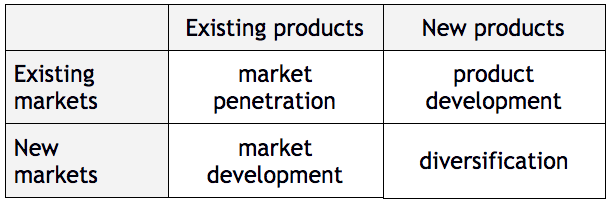 Strategies for each method of growth
Strategies for each method of growthMarket penetration: encourage consumers to use more, 'steal' competitor's customers (eg offer a special gift or collectables with each sale, '2 for 1' offers, 'Christmas' or 'Diwali' packaging design for a limited time, money-off voucher for introducing a friend).
Market Development: new uses for products, new markets geographically, new segments (eg Sell 'Nutrigrain' snack bars, IKEA opens a store in Auckland)
Product development: modify existing products (eg new shapes), upgraded model, 'me-too' copycat product
Diversification: risky as you have less knowledge & experience (may buy an existing business).
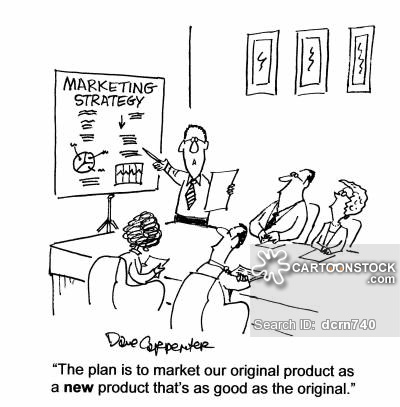
Discussion: In small groups, discuss whether the cartoon above about fire fits the definition of diversification in the table.
Activity: In Google Classroom, complete the Google Doc called 'Marketing Mix - Product'.Value Analysis
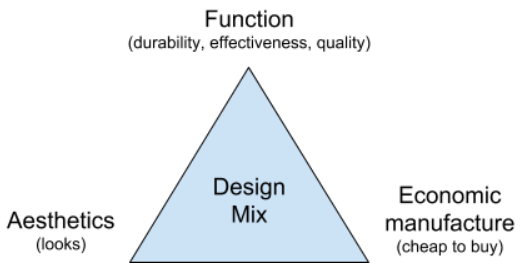 Value analysis is the process of deciding which product features most attract or satisfy a target customer's needs.For example,
Value analysis is the process of deciding which product features most attract or satisfy a target customer's needs.For example,- Function will be most important when buying a parachute!
- Fashion clothes or bought mostly on the basis of aesthetics (how they look).
- Economic manufacture is important for customers who have low income.
Activity: In the Google Doc called 'Marketing Mix - Product', answer the questions on Product Life Cycle.
Product Life Cycle
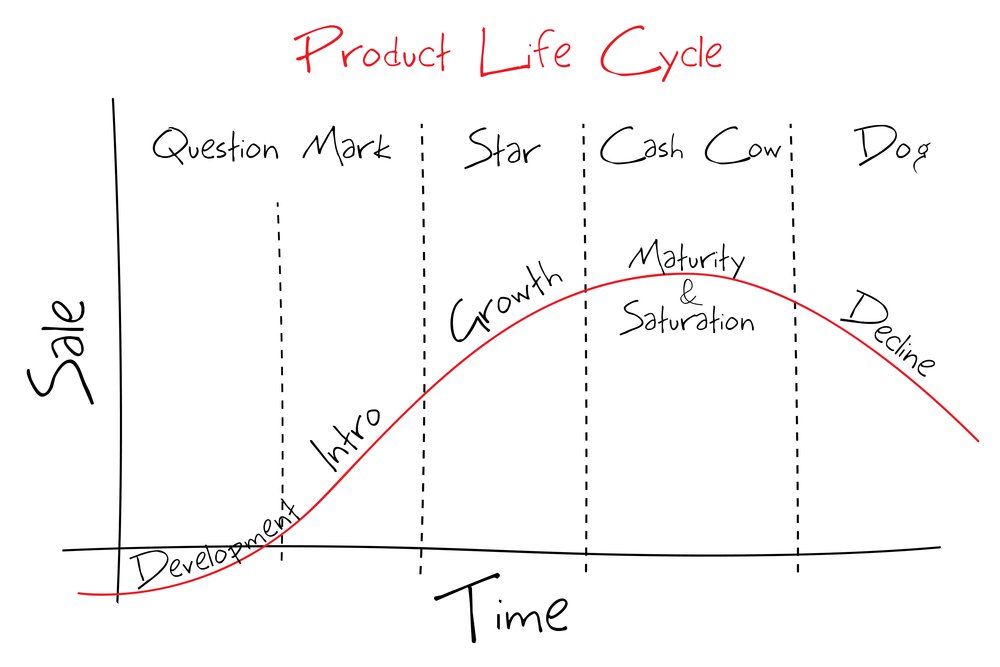 Sales, costs and profit of a product follow a series of stages over its life.
Sales, costs and profit of a product follow a series of stages over its life. When being developed, there are no sales, high costs and no profit - just losses.
A newly introduced product has slowly growing sales, high costs & no profit.
Sales increase rapidly during the Growth stage, unit costs start to fall and some profit may be made.
As competitors enter the market during Maturity, sales stop growing, costs reduce and profits are high.
When the market becomes saturated with too many businesses competing for customers, a price war can start and some businesses drop out. Costs remain constant, but sales and profits decrease.
The market declines and the product eventually becomes unprofitable.
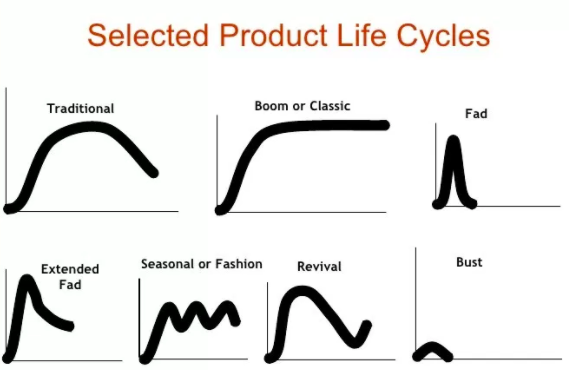
Discussion: In small groups, discuss the range of life cycle diagrams on the right and think of examples of real products for each one.
Activity: In the Google Doc called 'Marketing Mix - Product', answer the questions on Product Life Cycle.The life cycle is important because:
- each stage needs a different marketing mix
- a business needs products at different life stages to survive long term.

Extension strategies
Businesses try to extend products' lives beyond the saturation stage and so might repackage or slightly change it. Lux soap is more than 100 years old and its shape, perfume, colour, size and packaging have all changed to maintain consumer interest in it. Other extension strategies are finding new uses or accessories for the product. Examples of long lived products are Dettol, Bisto, Persil, Marmite, Coleman's mustard, Tetley tea.Life cycles are getting shorter as technological change accelerates. Products can become obsolete within months as more advanced versions are released.
Product portfolio
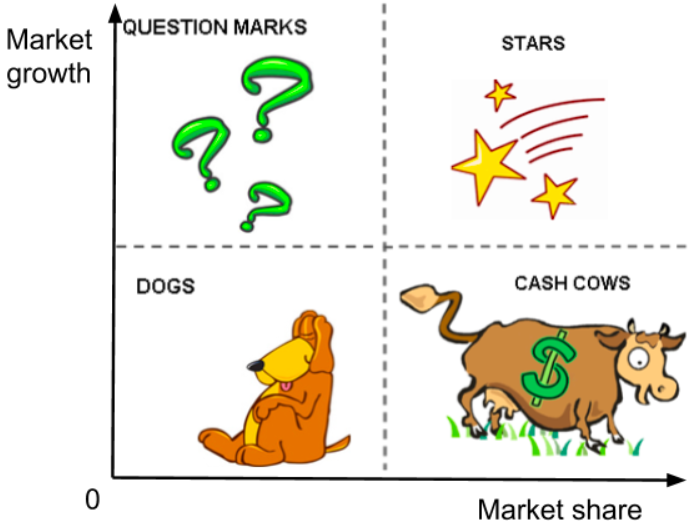
It helps to sustain your business to have a range of products at different stages of their life cycles, so that as sales of one decline, sales of others are growing.
In the product portfolio, some products may be cash cows, which are established brands in mature markets. The main work has been done. They sell well, bring money in, but are unlikely to increase sales. Every business wants these!
Stars are also great to have because, not only are they strong brands in the market, but also the market is growing and so income and profits will probably increase.
Dogs are products that are sold to the last, loyal, 'die hard' customers. They are not attracting new consumers and will probably be phased out.
Question marks are in a growing market and may become established, popular brands, but this is uncertain. Work is needed here to make them stars.
Obsolescence
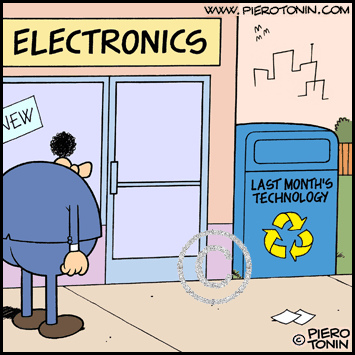 Obsolescence is the process by which products become disuded, discarded or 'overtaken' by more up-to-date versions or products (eg vinyl records, magnetic cassette-tapes, CDs, MP3 players).
Obsolescence is the process by which products become disuded, discarded or 'overtaken' by more up-to-date versions or products (eg vinyl records, magnetic cassette-tapes, CDs, MP3 players).
Built-in obsolescence results from the product's design or durability (ie how long before it wears out).
Planned obsolescence is making a product out of date by deliberately introducing a new version or product.
Discuss examples of products that became obsolete without their manufacturer's intention.
Discuss examples of products that are obsolete because their manufacturer deliberately released a new product.Discuss why obsolescence might benefit a company (eg Apple iPhones).
-
Learning Intentions

- Explore product differentiation & branding (part of the Product element of the 4Ps).
- Focus an analysis of a product or business by using a SWOT analysis.
- Can explain the purpose of branding (including logos and slogans) and identify popular examples.
- Can perform a SWOT analysis to analyse a product or business.
- Can describe 4 reasons for packaging and analyse a product's packaging.
Product differentiation and Branding
Businesses often use slogans, for example "The Warehouse, where every one gets a bargain" and "Briscoes, you'll never buy better".
 They also use logos These marketing tools are designed to be memorable and businesses spend a lot of time and money associating them with certain values and emotions in customers. They are a large component of the brand'.
They also use logos These marketing tools are designed to be memorable and businesses spend a lot of time and money associating them with certain values and emotions in customers. They are a large component of the brand'.A brand is any name, term, symbol or distinctive packaging that identifies specific goods or services and helps to differentiate them. With legal protection, it becomes a trademark. Brands can be linked to businesses, single and family line products. Branding helps to achieve marketing objectives by:
- being a focal point for advertisng
- encouraging repeat purchase (customer loyalty)
- allowing non-price competition (product differentiation)
- making it easier to expand a product range
- making it cheaper to advertise (the whole brand rather than every individual product)
Branding can hep customers by:- making it quicker to identify 'good' and 'bad' products
- identifying the business behind the product
- encouraging the business to provide consistent quality
Single product line and Multiple product line
Some businesses produce just one product and advertise its brand eg WD40 spray and Crocs shoes. Others produce a wide range of different products and advertise both each one but also the business's brand eg Kelloggs make a wide range of food products, but the name Kelloggs is prominent on packaging and in advertising.
Here's a great online article on this topic
Packaging
There are 4 reasons for packaging:
- Ease of carrying and protection eg liquids, fragile or dangerous goods, powders
- As part of the Marketing Mix - it can contain the trademark or logo, be eye-catching or distinctive. New packaging can be a cheap way to give the impression that the product has been changed or improved.
- To enhance apparent value to the customer and thus enable higher prices and profits eg perfume, Ferrero Roche chocolates
- Makes stock taking easier - especially in self service stores where theft or damage may be issues.
Product oriented vs Market oriented
A business that is product orientated has a dominant production or research & development department that creates a product and then relies on the marketing department to find a market for it. A market orientated business has a dominant marketing department that identifies trends and needs and then asks the production department to create products that meet that need.As a class, we'll listen to Lucy Kellaway's radio clip on the internet of things and new product development, entitled 'We need smart products because we're stupid'. Given that she believes no-one actually needs "a fridge that tells you when you need more milk", consider whether the internet of things is a market or product oriented development. - Explore product differentiation & branding (part of the Product element of the 4Ps).
-
Learning Intentions
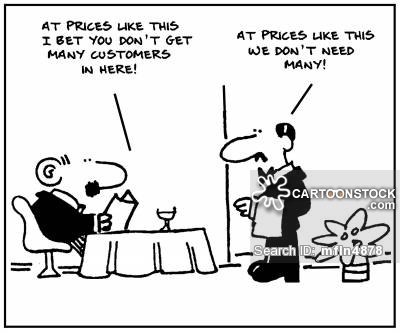
- Investigate ways in which businesses can price their products
- Explore examples of different pricing strategies and reasons for using each strategy.
- Explore the specific effect of changes in price on quantity sold and thus on profit.
- Can describe several key strategies for pricing products
- Can predict the effect of a price change on sales and thus profits.
Price
The price of o product sends strong messages to consumers. Would you buy a parachute in a sale at half price, or a perfume, for a valued friend, that was advertised as being low price, or petrol at a much higher price than competitors' prices?
Pricing strategies
- Cost-plus pricing - adding a percentage markup to the estimated unit cost.
- Penetration pricing - initial low price to encourage customers to try the product (but could send the message of low quality).
- Skimming - high price until competition forces it down
- Competitive pricing - in line with, or a certain percentage above, competitors' prices.
- Psychological pricing - appears closer to customer's perceived value (eg $3.99)
- Prestige price - to promote a luxury image (eg perfume)
- Price discrimination - price for the same product varies for different customer groups (eg students, off-peak travel).
- Loss leader - very low price attracts customers into the shop to buy other products at 'normal' prices.
- Promotional pricing - low price for a short time to renew customer interest or clear unwanted stock.
- Range pricing - prices of similar types of product kept within limits.
In your group, discuss which price strategy is being used in each of the examples below:
- A watch that’s very similar to others sold in the shops
- A toy sold for $1.95
- A tour operator sells holidays during the school holidays as well as at other times.
- A new brand of washing powder is launched - there are several similar ones already available
- A supermarket wants to cover the cost of vegetables and make a 100% profit as well.
- A new mobile phone has been developed that has extra features compared to the competition.
Price Elasticity of Demand (PED)
PED is a measure of the responsiveness of demand of a product to a change in its price (ie how much quantity sold will change if you change price).
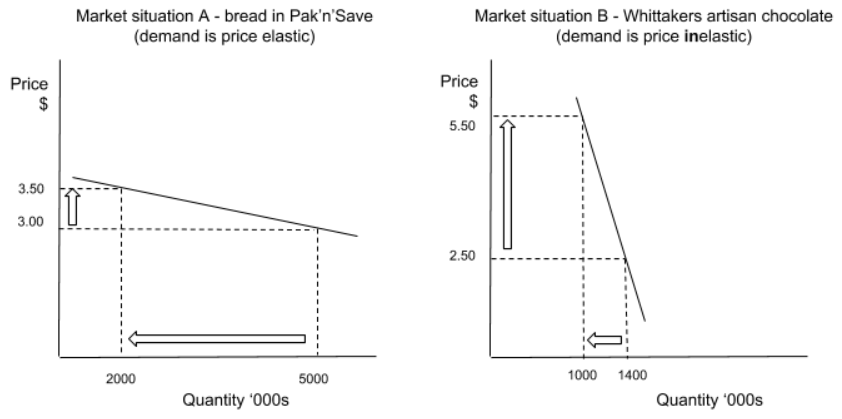
Market for bread: A small increase in price causes a large decrease in quantity sold
Market for Whittakers chocolate: A large increase in price causes a small decrease in quantity sold.
This is important because any change in price affects your total income.
Consider whether, in order to increase total income, we should i) increase the price of bread OR increase the price of Whittakers chocolate.
Using the equation Price X Quantity = Total Income, calculate the income earned before and after each price change:Income from bread sales before the change: $3 x 5000 = $15,000. Income from bread sales after the change: $3.50 x 2,000 = $7,000. Even though we are receiving more money from each loaf, our total income from selling bread has decreased.
Income from chocolate sales before the change: $2.50 x 1400 = $3,500. Income from bread sales after the change: $5.50 x 1000 = $5,500. We are receiving more money from each loaf, AND our total income from selling bread has increased.
It makes sense, in this example, for us to increase prices of Whittakers chocolate, but not of bread.
Calculating Price Elasticity of Demand
It's possible to calculate a number (called the Coefficient of Elasticity) that represents the price elasticity of demand for a product. This enables us to predict the effect of a price change. There are 2 methods: percentage method and mid-point method.
Percentage method uses % change in quantity which is (change in quantity / original quantity) x 100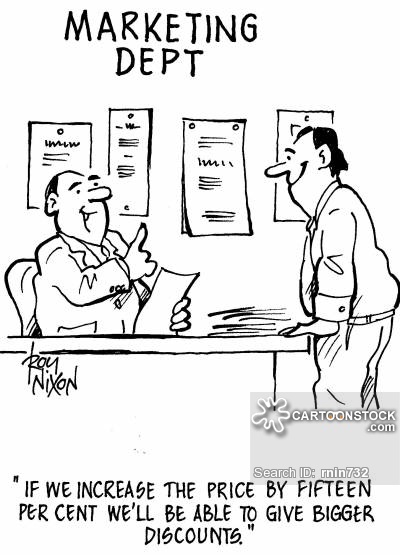
% change in price (change in price / original price) x 100For bread: -(5000 - 2000) / 5000 x 100 = -0.6 x 100 = -60 = -3.53 (larger than 1 and so demand is price elastic)
(3.50-3.00) / 3.00 x 100 0.17 x 100 17For chocolate: -(1400 - 1000) / 1400 x 100 = -0.29 x 100 = -29 = -0.24 (< 1 and so demand is price inelastic)
(5.50-2.50) / 2.50 x 100 1.2 x 100 120NB: Both coefficients are negative. This shows that price and quantity have a negative relationship - as one goes up, the other goes down.
Mid-point method also uses % change in quantity BUT this is (change in quantity / average quantity) x 100
% change in price (change in price / average price) x 100For bread: -(5000 - 2000) / 3500 x 100 = -0.86 x 100 = -86 = -5.7 (larger than 1 and so demand is price elastic)
(3.50-3.00) / 3.25 x 100 0.15 x 100 15For chocolate: -(1400 - 1000) / 1200 x 100 = -0.33 x 100 = -33 = -0.44 (smaller than 1 and so demand is price inelastic)
(5.50-2.50) / 4.00 x 100 0.75 x 100 75Which method should I use?
Use the Mid-point method because it calculates the same answer whether the price and quantity are increasing or decreasing.
If you don't believe this, re-calculate the price elasticity of bread and Whittakers chocolate, but this time decrease the price between the same points (ie change the arrow directions). Do this using first the percentage method and then the mid-point method.
Answers: Did you calculate figures of -10.7 and -0.74 using the Percentage Method? Did you find no change using the Mid-Point Method?
In your group, consider what types of product might have a price inelastic demand and which might have a price elastic demand.Extension reading
If pricing and consumer psychology interest you, this online article provides an interesting insight into the science behind pricing and purchasing decisions. -
Learning Intentions
- Investigate ways in which businesses distribute their products to customers.
- Explore examples of different distribution channels and what affects business's choice of channel.
- Can describe several ways to distribute products and the factors that affect this choice.
- Can provide examples of different distribution channels.
Place
Distribution (Place) ensures products are available to customers in the right quantity at the right time in the right place. It involves questions like:
- Where do consumers prefer to buy the product?
- How can we ensure the product is available to existing and potential customers?
- How important are speed, timing, cost, availability
- How much stock should we hold? Too little and we run out; too much and we tie up cash (that then cannot be used to pay daily expenses)
It depends on:- The product - is it perishable, technically complex, a convenience item?
- The market - is it geographically spread out, highly competitive?
- The business - is It large, supplying producers or consumers?
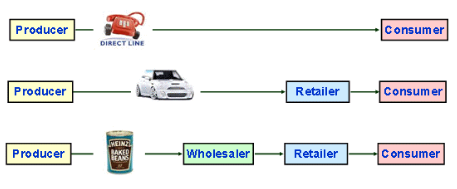 A distribution channel is the means by which the product moves from production to consumption. It might include:
A distribution channel is the means by which the product moves from production to consumption. It might include:- Retailer sells direct to households / end users / consumers
- Wholesaler sells products from different manufacturers to retailers; they 'break bulk' by putting large quantities into smaller packages
- Distributor have a contract to sell a manufacturer's products
- Agent a 'go-between' who never owns the product and earns commission eg real estate, insurance, travel.
- Franchisee allowed to trade under the the manufacturer's name; pays a fee and gives a share of the revenue to the franchisor
- Direct selling door to door, mail order, sales reps
Trends in distribution are:
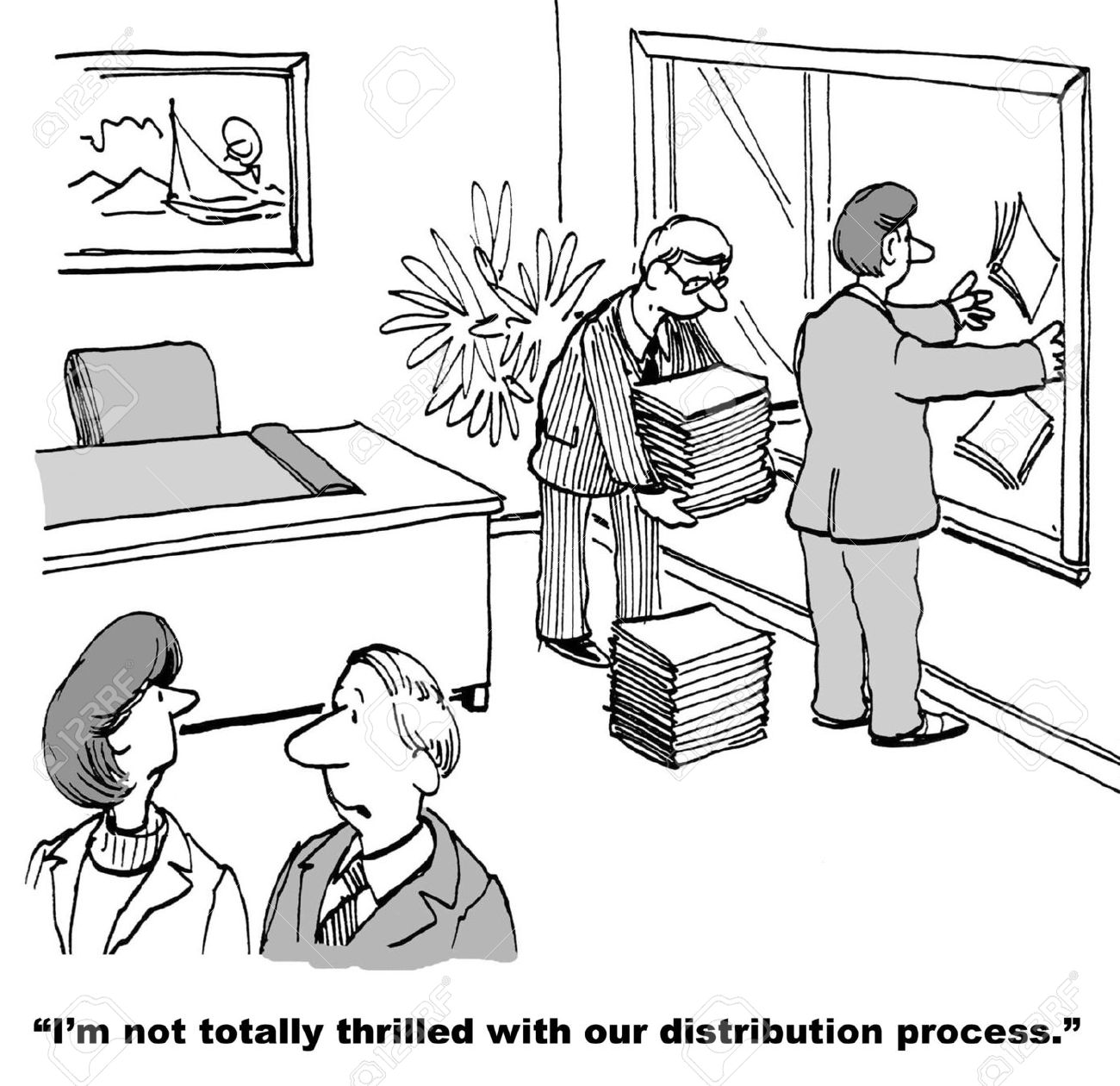
- more out of town stores and malls;
- fewer independent and more multiple / chain retailers;
- more franchises (eg Jim's mowing);
- online shopping and home delivery.
- drone and driverless delivery??
NZ's supermarket duopoly
Read the following article. Note which companies own Pak'n'Save, New World, Countdown. In your group, discuss how it affects you and your family that two companies dominate the NZ supermarket industry.
NZ Herald: Big two supermarket chains locked in fierce food fight
In your group, find out the meaning of 'parallel imports' and discuss why they might be cheaper to buy and whether there are any disadvantages.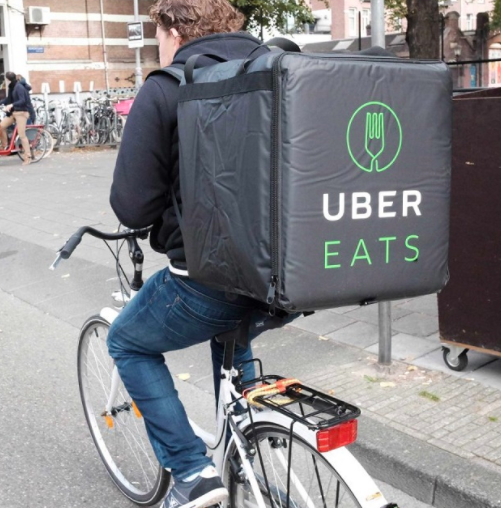
Extension activity
Research the service that Uber Eats provides.
Consider the impact on distribution of restaurant food.
How do restaurants and householders benefit? -
A week for catching up on the term's work - several students away on trips and some work outstanding in Google Classroom.
Short video on Coca-Cola Marketing campaign
Website on effects of Coca-Cola on your body!
https://www.medicalnewstoday.com/articles/297600.php
NB Make sure you click on the link in the above Medical News Daily article to Naik's infographic
Here is a link - IT IS SCARY!! https://therenegadepharmacist.com/what-happens-one-hour-after-drinking-a-can-of-coke/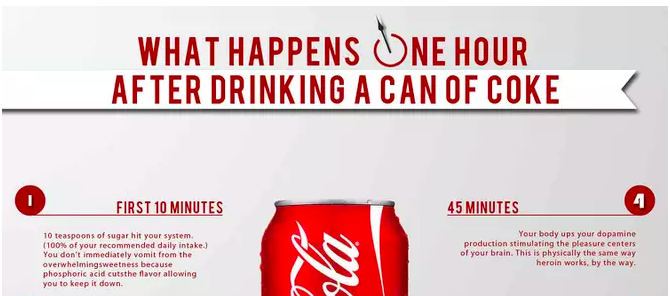
-
Learning Intentions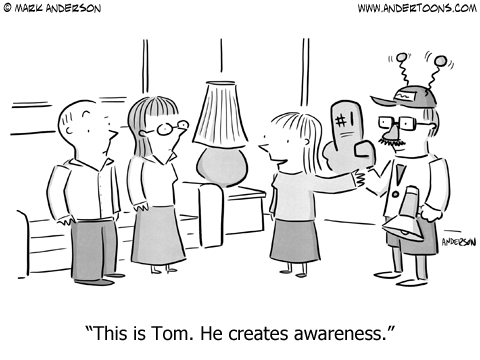
- Investigate the purposes of promotion and how businesses promote themselves and their products.
- Explore examples of different promotion methods and what makes them successful.
- Can describe several ways to promote products and the aim of each one.
- Can analyse examples of promotions.
Promotion
Promotion is a range of techniques for communicating with the 'external environment', especially customers. These techniques include:
- Advertising is any communication paid for by the sender and intended to inform, influence or persuade the receiver.
- Personal selling any person to person communication designed to inform potential customers or to persuade them to buy.
- Sales promotion is any financial or economic incentive to encourage a customer to buy.
- Publicity also known as public relations, is communication free of charge which is either within, or out of, the sender's control.
Promotion objectives
The objectives of promotion are summarised by A.I.D.A.:
- Awareness To get people to know that your product exists
- Interest To get people to be interested in what your product might do for them
- Desire To make people want to have your product
- Action To get people to actually spend money buying your product

The purpose of each promotion technique
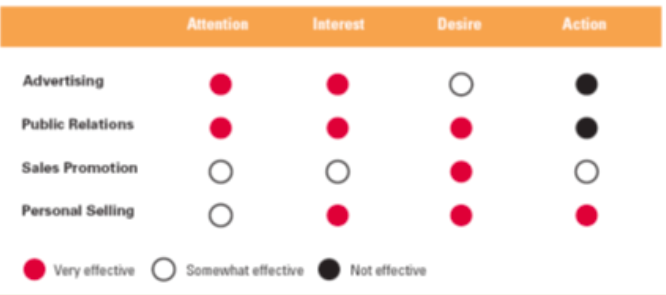
Advertising is better at telling people that `your product exists and making them interested to find out more. An advert on the TV, say, is unlikely to make a person jump in the car go to the shop and pay money to buy your product.
A sales promotion, such as "buy a Nissan Leaf car in July and we'll give you free insurance for two years" might get people to decide that your car is the one they want. It might perhaps encourage them into the shop, but it is the salesperson who will finally actually convince them to pay money.
Examples of promotions - discuss whether each promotion will achieve Awareness
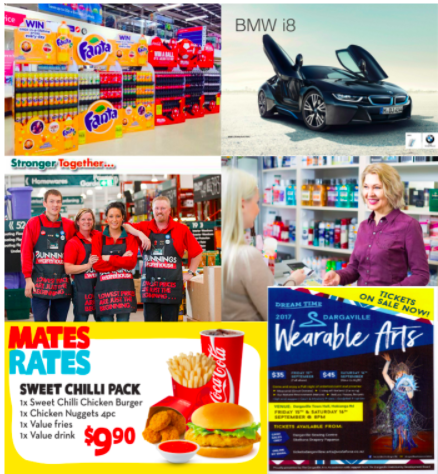
-
Learning Intentions
- To review last term's learning, especially promotion
- Can draw on relevant knowledge on Marketing to answer a range of business questions.
Promotion continued
Another consideration when planning promotion is whether the business is trying to get new customers to try the product for the first time or whether they are trying to get existing customers to keep buying the product. Try answering these 3 multiple choice questions:
1. A publishing company is about to launch a new magazine aimed at female readers aged 14-20. Which two of the following would be direct ways in which the company could try to get potential readers to buy the first issue of the magazine? (Select two answers).
- A) Keep production costs low
- B) Offer a free lipstick with the issue
- C) Take on extra staff
- D) Sell the first issue at half price
- E) Cut advertising on the other magazines by the company
2. A car manufacturing company is worried that there is little customer loyalty amongst car buyers for its vehicles. The lack of customer loyalty is most likely to mean that (select one answer):- A) customers are buying a different make of car when they sell their existing car
- B) car sales for the company are increasing
- C) the cars the company sells are seen as being good value
- D) it would be more profitable for the company to make large cuts in the price of its cars
3. A company making frozen pizzas depends for its success on repeat purchases. Customers are most likely to make repeat purchases because (select one answer):- A) it determines the amount of profit the company makes
- B) it increases sales of pizzas
- C) the company spends heavily on advertising
- D) in the pizza market, customers have little brand loyalty
Questions to check understanding
Here are links to some multiple choice questions. See if your small group can answer them:
- https://www.tutor2u.net/business/quiz/marketingmix20/quiz.html
- https://www.bbc.com/education/topics/z96pyrd
Resources
Digital MarketingP&G - the world's largest marketer slide show
https://www.slideshare.net/HarshitGupta245/harvard-case-study-analysis-pg -
Learning Intentions

- To reflect on our understanding of Marketing topics and to prepare questions for the guest Marketing Executive from Krispy Kreme.
- To prepare for the issuing of the NCEA assessment (brainstorming products to choose from and evaluating exemplar answers).
- Can identify Marketing concepts that are not fully understood and discuss these with a Marketing Professional who is working in the field.
- Can describe the requirements of the NCEA assessment and have identified a small number of potential products and research sources.
Dove - a Marketing case study
In Google Classroom is a slide presentation case study of the marketing of Dove products. Study the presentation slides and write a question on a post-it note for the class to help revise marketing.
Antonio Rivera, Operations Manager
(Rebecca Woodley, Marketing Executive)
On Tuesday 14th May at 11am in room M6, Antonio Rivera is visiting us at school. Antonio is in charge of Krispy Kreme's Marketing in New Zealand. He has kindly agreed to share elements of Krispy Kreme's marketing strategy, and details of their Marketing Mix. This is very relevant to your NCEA assessment.
-
Learning Intentions
- To apply what we've learned in class to a real life product
- To experience an NCEA Level 1 assessment (and hopefully gain 3 credits at Excellence)
- Have decided which product's marketing mix to analyse and have planned, and completed, research.
- Have completed part of the final report
This week, you Explore. Focus and start to Plan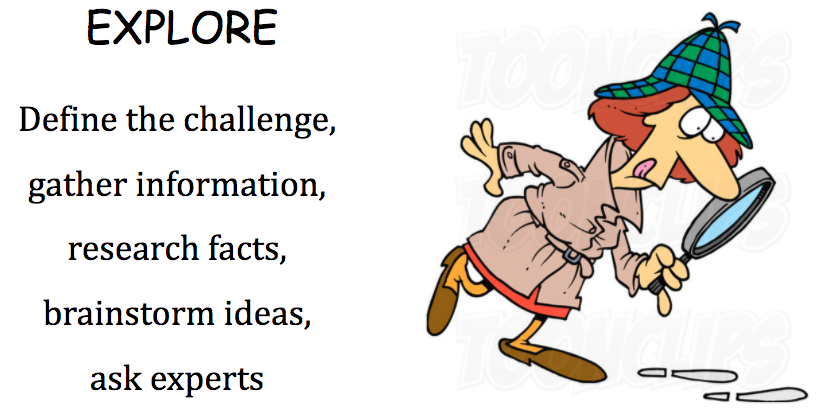
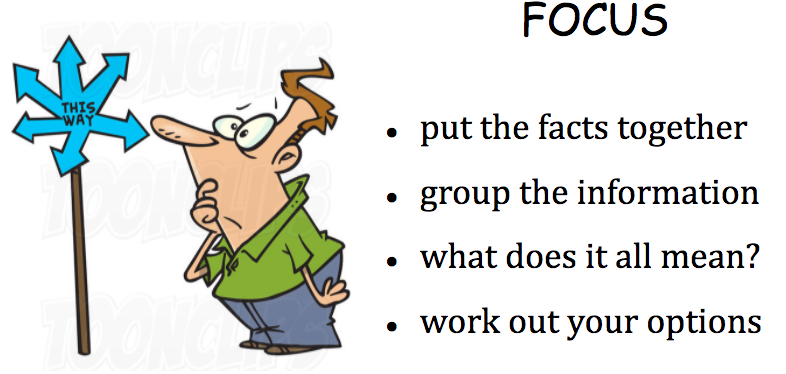
NCEA 1.4
NCEA AS90840 (1.4) Apply the marketing mix to a new or existing productLOOK at these examples of student work as90840 and read the examiner's comments.
http://www.nzqa.govt.nz/ncea/subjects/business-studies/annotated-exemplars-2/level-1-as90840/ -
Learning Intentions

- To apply what we've learned in class to a real life product
- To experience an NCEA Level 1 assessment (and hopefully gain 3 credits at Excellence)
- Have shared the draft report with your teacher and other students for feedback.
- Have read the student instructions again and the examples of student work with examiner comments
- Have completed the draft final report
This week, you Plan and start to Do (create) your report.
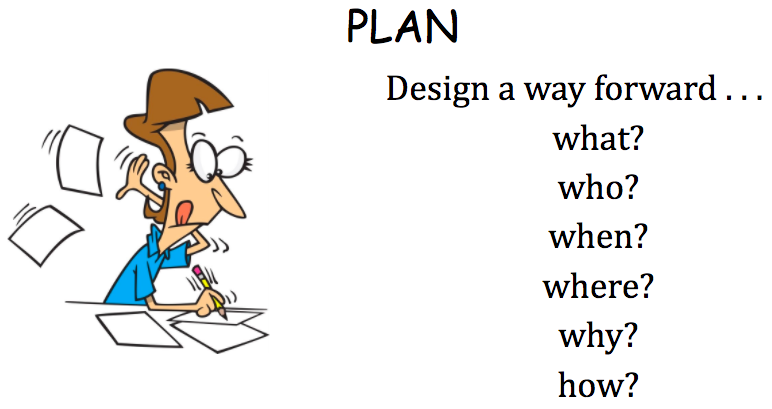
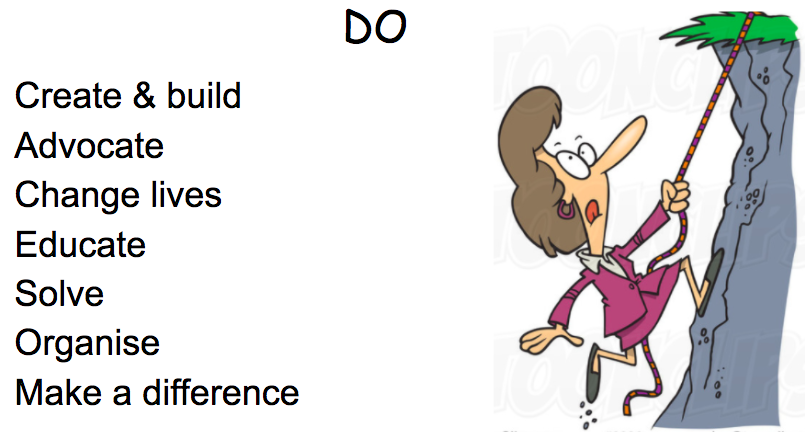
Seek feedback from other students and the teacher
-
Learning Intentions- To apply what we've learned in class to a real life product
- To experience an NCEA Level 1 assessment (and hopefully gain 3 credits at Excellence)
- Have read the student instructions again and the examples of student work with examiner comments
- Have completed the final report
Finish your draft report & submit in G Classroom for feedback.
This is NOT your final report
-
Hi all, Please continue to improve your Marketing Mix report assessments, based on the individual feedback provided.
Here's some general feedback for everyone:
1. Mark a friend's report using the student instructions sheet and/or the marking schedule. Be critical and honest, not 'nice'!
2. Ensure your paragraphs are SEXY (statement, example, explain, your opinion) and no more than say 5 or 6 lines long.
3. There MUST be one or two Maori values or concepts and you must say why they're relevant to the product or business.
4. You MUST fill your report with business vocabulary to explain what's happening, NOT just a description of the product.
5. You may lose marks for including too many facts that are not relevant or are not explained using your business knowledge. "Less is more"! Excellence is possible (more likely) in shorter, well thought out reports. Don't just include info because you have it - it counts against you if you just dump facts on the page.
6. For Merit, you need reasons, causes, effects, comparisons with competitors, and links to other Ps and to marketing terms and vocabulary - answer the question 'So What?'.
7. You MUST have a Bibliography with references briefly described on the last page. Some referencing through the report would be good.
Good luck and well done for your work so far.
Mr S :)SUBMIT your Marketing Mix Assessment HERE :)
What's in the news?
In Google Classroom, several links to news articles have been shared.
Choose some to read and investigate further. Be ready to discuss the issues raised in these articles.
Prepare to get annoyed, outraged and even angry at some of the things that are described!! -
Learning Intentions (based on NZ Curriculum Level 5 Achievement Objectives)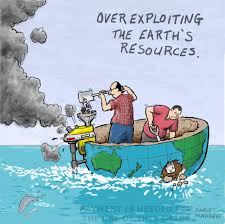
- Understand how economic decisions impact on people, communities, and nations.
Understand how people’s management of resources impacts on environmental and social sustainability.
Success Criteria
- Able to explain the definition of economics (scarcity, resources, wants, etc.
- Can share examples of how economics affects our everyday lives
Economics
Economics affects everything you, your friends and family do. It is the study of how to allocate scarce resources in order to satisfy unlimited wants and needs. Put simply, it's deciding what OUTPUTS (products) to produce and what INPUTS (resources) to use to produce them.
For example, should we: only use public transport, build more dams to encourage dairy farming in drought-prone regions, use nuclear powered ships, employ more nurses, pay politicians higher salaries, pay university fees out of taxes, have a larger army, charge tourists more to walk the Milford Track, allow only 2 companies to control all supermarkets, limit the amount of fish that can be caught, ban cigarettes, allow deforestation if it creates temporary jobs, etc.
In Economics, there are 4 types of resource (called the 'Factors of Production') that are used to make goods and services that people need or want. These are:
Natural resources - 'Land', trees in a native forest, rivers, iron ore/oil/rock/sand
People resources - 'Labour', teachers, lawyers, politicians, programmers, artists
Human-made resources - 'Capital', buildings, roads, trucks, ferries, computers
Enterprise - People who have an idea and bring the other three types of resource togetherHere's a short video clip that explains the 4 types of resource (Factors of Production), Opportunity Cost and Micro- and Macro-economics.
JUST watch to the 1:20 minutes point!
Activity 1
Imagine that there's a natural resource deep underground that can be used in power stations to generate electricity. Imagine that it burns cleaner than coal. Should we try to extract it? Maybe!
Now imagine that Entrepreneurs had an idea for a process, called 'Fracking', to extract such a resource. It uses capital resources (machines, pumps, chemicals, concrete), natural resources (water) and human resources (low wage workers). Should we use this process and the resources that it needs? Maybe!Well, the resource and the process of Fracking do exist. The resource is called Shale oil and gas. NZ and many countries allow companies to use 'fracking' to extract this natural resource. Others have banned the process.
Large profits can be made because the revenue from selling it is higher than the costs of drilling and transporting it. There are other costs, but drilling companies do not have to pay these - local residents pay these other costs!
Extracting Shale oil by Fracking uses resources that could be used by other entrepreneurs to produce different, less damaging products (eg wind and wave turbines). The benefits of the alternative products that we now can't have, because the resources are tied up in fracking, are called an Opportunity Cost of Fracking.
The Fracking process and disposing of its toxic waste, destroys other natural resources like clean drinking water, farm land for growing food and destroys the health and ability to work of human resources (local residents). These are large costs that the companies cause, but don't have to pay for and are called externalities.
Should we frack for shale oil and gas in NZ? Not so sure!? Watch these two videos and decide.
Accounting Cost is the money amount that we must pay (explicit cost).
In Economics, we also talk about Opportunity cost.
Opportunity Cost is the benefits that we miss out on because we've used our resources to produce one product and not another. For example, if you have $20 and pay for a movie ticket (and the enjoyment this gives you), you cannot have the next best alternative (perhaps the fun with your friends of buying a new basketball).
Economic Cost is Accounting Cost plus Opportunity Cost. For example:
If I buy wheat seeds and sow, water, fertilise and finally harvest them, I might have to pay $40 for seeds, water, my time, etc. I might sell the wheat for $100. My Accounting profit is $100 - $40 = $60
If I could have earned $55 from allowing campers to stay on the land, the Opportunity Cost is $55 (the next best alternative use).
My Economic profit from the wheat is $100 - $40 - $55 = $5. Because Economic Profit is a positive amount, I made a good choice to use my land, labour, capital & enterprise to grow wheat. I would have made $5 less profit from the next best alternative use of my resources.
Types of Economics
There are two types of economics:
Micro-economics studies individual industries and businesses eg competition, Monopoly power, Supply & Demand
Macro-economics studies whole country topics like inflation, growth, unemployment, investment, exports and trade.Real life example of Economics in action

The Ruataniwha dam in Hawkes Bay will flood a large area of land in order to provide irrigation water for increased dairy farming in an area prone to drought. Environmentalists say that it will damage the quality of water in the region, encourages a form of farming that is unsustainable in this dry area, and will use millions of dollars that could be better spent elsewhere.
Some investors want the scheme because they think it will generate large profits for them. However, the latest assessments estimate that farmers will not afford the high price the water will have to be sold at to cover the huge costs. This case study can be explained in terms of scarce resources, factors of production, opportunity cost, who gets to choose what is produced with our resources, micro- and macro-economics.
Here are two links to articles about the proposed scheme
2018 article: https://www.radionz.co.nz/news/national/360937/ruataniwha-dam-scheme-revival-raises-doubts-in-hawke-s-bay
2019 article: https://www.stuff.co.nz/environment/110889921/the-ruataniwha-dam-proposal-might-be-dead-but-now-another-dam-is-touted-on-the-same-river-with-ratepayer-funding-soughtActivity
Work in small groups to individually complete the Google Doc titled "Ruataniwha Dam" from Google Classroom. You'll need to read the article above and discuss who is affected, how the decision should be made and whether you think the scheme should go ahead.
- Understand how economic decisions impact on people, communities, and nations.
-
Learning Intentions
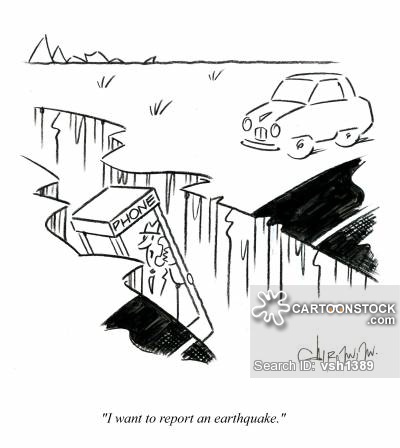
- To understand how limited resources affect what NZ can produce (and earn)
- Able to show in a graph how limited resources affect what can be produced in NZ
Production Possibility Curves (PPC)
It is useful to show on a graph the maximum that we can produce with available scarce resources. To do this though, we have to pretend that we can only produce 2 products. Such a graph is called a PPC. Imagine that we can choose to produce surf boards and / or Moro bars. The curve below shows that we could produce any combination of these 2 products up to the line (eg points A and B, but not outside it (point C).
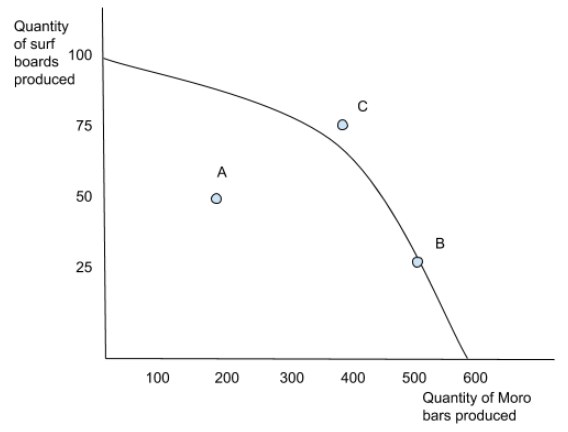
For example, we could produce 50 surf boards and 200 Moro bars (point A), or 25 surf boards and 500 Moro bars (point B). We do not have enough resources to produce 75 surf boards AND 400 Moro bars (point C).
Activity
Discuss in your group what would happen to the PPC curve (quantity that can be produced) if:
- more immigrants came to the country
- an earthquake destroyed factories and roads
- there were widespread floods across the country
- more efficient machines were developed that could produce more Moro bars
Activity
Watch this video clip of the NZ earthquake. Seeing the damage caused, think about what the effect was on the region's resources (land, labour and capital), ability to produce products and Production Possibility Curve.
Activity
Complete the Google Doc in Google Classroom called Intro to Economics. -
Learning Intentions
- To explore how supply and demand affect prices in a market
- Able to describe what causes changes in quantity supplied and demanded (and in supply & demand).
- Able to describe consequent changes in price, surpluses and deficits.
Supply curve
A supply curve plots price of a product against the quantity supplied (by producers).
It slopes from bottom left to top right, because the higher the price, the more producers want to make and sell it.
We assume that only one 'variable' changes at a time.
If price of the product increases, we move to a new point along the curve - called an increase in quantity supplied.
If price stays fixed, but one other 'variable' changes (eg productivity, cost of raw materials), then the curve itself shifts to the right (increase in Supply) or to the left (decrease in Supply).Demand curve
A demand curve plots price of a product against the quantity demanded (by consumers).
It slopes from top left to bottom right, because the higher the price, the fewer consumers want to buy it.
We assume that only one 'variable' changes at a time.
If price of the product increases, we move to a new point along the curve - called a decrease in quantity demanded.
If price stays fixed, but one other 'variable' changes (eg incomes, prices of other related products), then the curve itself shifts to the right (increase in Demand) or to the left (decrease in Demand).Activity
Complete the Google Doc in Google Classroom called Supply / Demand Activities. -
Learning Intentions- To explore business aims and objectives, and the conflicting interests of different stakeholders.
- To explore how business impacts on society and how pressure groups and government can influence decisions.
- To explore why some businesses are run sustainably and 'environmentally', and some are not.
- Can explain different business goals that influence an issue.
- Have raised awareness or advocated a change of practice, beyond school (eg article presentation, emails)
- Can describe different stakeholders in a business issue.
 awareness (eg by writing a news article, presenting a slide show) or advocate to change policy by persuading a company, Councillor or Member of Parliament.
awareness (eg by writing a news article, presenting a slide show) or advocate to change policy by persuading a company, Councillor or Member of Parliament. The instructions are in Google Classroom in a doc called 'Business Issues'.
Task: Imagine that you are a journalist or news blogger. Prepare an ‘article’ that explains an issue that affects or interests you and involves business. Your article can be in the form of a podcast, written article, video clip, slideshow or other presentation.
As a guide for you, news and opinion items on Stuff.com are about 500 words in length, have an eye-catching title and often include a supporting photo.
The audience is likely to be people who do not have a business background or specialist knowledge. We will aim to get some articles published in the local Eastern Courier or Howick & Pakuranga Times.
If you wish, you may alternatively draft your research findings and send emails to those people you believe can influence the situation. Your emails need to be well informed and based on thorough research.
-

Learning Intentions
- To explore business aims and objectives, and the conflicting interests of different stakeholders.
- To explore how business impacts on society and how pressure groups and government can influence decisions.
- To explore why some businesses are run sustainably and 'environmentally', and some are not.
- Can explain different business goals that influence an issue.
- Have raised awareness or advocated a change of practice, beyond school (eg article presentation, emails)
- Can describe different stakeholders in a business issue.
You should by now have looked through the resources on business issues (eg pollution, health) and chosen an issue that is of interest to you.
Research the winners and losers in this issue and the organisations that should protect the 'losers' and that are enabling the 'winners' to continue.
Try to understand exactly why the problem continues and what the costs are on all the people involved.
-
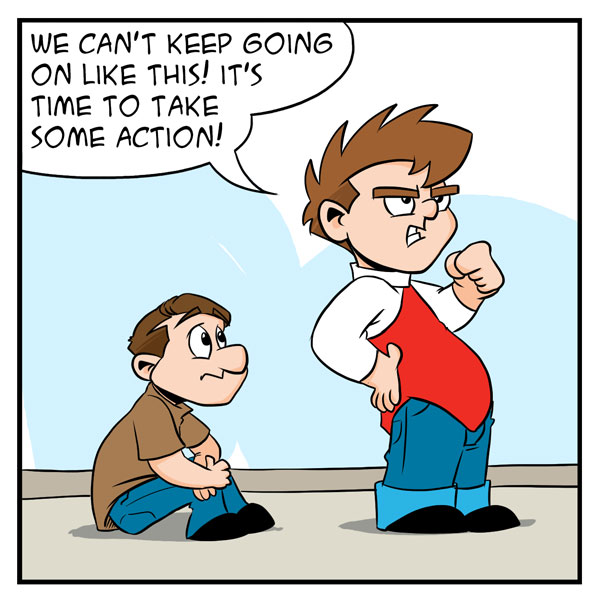
Now you have a full understanding of your business issue - it's causes, effects, enablers (those allowing it to continue) and potential change agents (those that could change it), it's time to finish drafting your poster, slide presentation, email list, news article, etc. In other words, it's time to DO something to change things. -
Assessment 2
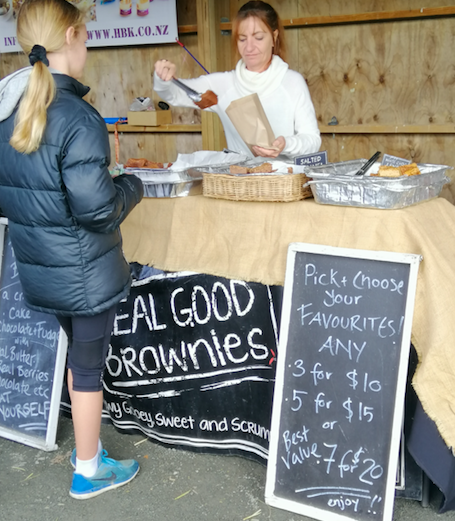
Assessment deadline is Friday. Make sure you've submitted it early for feedback.
Market Day
START THINKING ABOUT MARKET DAY on Tuesday of Term 4 Week 1 (15th October).
Rules:
- No on-selling existing products (eg Sprite) - you must make all your products from raw materials.
- As a Year 10, you are expected to have original, creative and high quality ideas & products.
- A product is
- a good (artwork, craft, food, soap, plants, etc) or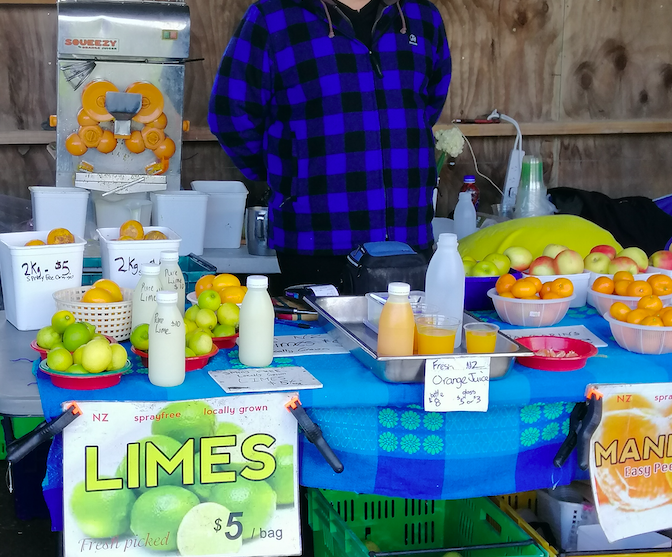
- a service (wash, paint, advertise, organise, etc) - Maximum of 4 group members
-
Business Scenario
Learning Intentions
- To explore how financial information is used to make decisions.
- To explore how businesses record financial information.
- To experience running a business as a team in a simulation scenario
- Can explain how financial and non-financial information supports decision making at home and in business.
- Able to record transactions in a Cash Flow Statement and summarise them in a Balance Sheet & Income Statement
- Have run a simulated business as a team.
Introduction to Accounting and the Business Scenario
Accounting is recording and analysing financial information to help people to make decisions. The Google Doc in Classroom has some notes and activities.
This term, we'll work in small teams to simulate running a business. We'll pretend that the term covers the 6 months January to June. Each week, the teacher will give your team a card or situation that you have to discuss, make a decision on, and then record the effects in a Cash Flow Statement. Later on, you'll prepare a Balance Sheet (Statement of Financial Position) and an Income Statement (Statement of Financial Performance in order to summarise what's happened.Everything you need is in the Google Doc called Business Scenario in Google Classroom. The tables that you'll be completing look like these below:
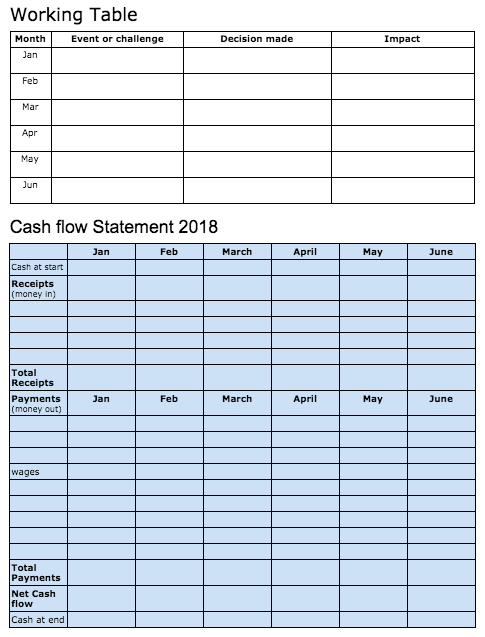
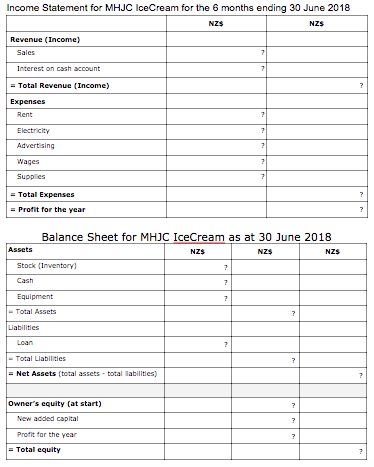
-
Learning Intentions
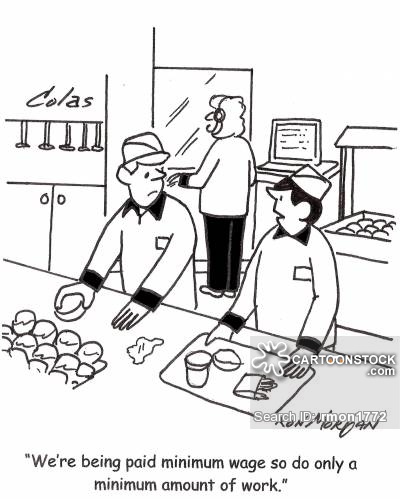
- To explore the ways people earn income.
- To explore the 'Labour Market' and the relative gains of wealth and income.
- Can describe different types of income and tax.
Income
The Labour market is the way in which suppliers of labour (workers) and those that demand (and pay for) labour (businesses) come together to exchange.
Consider whether the labour market is fair! Discuss whether Neymar is worth $90 million per year, (Ronaldo $108M and Messi $111M). Explain why you think this. Then discuss whether nurses or less valuable to society than football or basketball players? Discuss whether the pay you receive reflects the value society places on you, or whether it reflects some other factor.
Answer the questions in the activity on Google Classroom called "Income".
Types of income
Wages are based on an hourly rate multiplied by the number of hours worked. They are often paid for manual work, eg in the building and retail industries.
Salaries are stated on a yearly basis, although they are paid in instalments, normally every two weeks. The same amount is paid, no matter how many hours are worked! Teachers, managers, accountants are usually paid this way.
Independent contracting is when a person with specific skills works for a business to do a specific task, normally for a set period of time and for a set amount of money. At the end of the contract, they find a new contract for a new client. Contractors are viewed as self-employed.
Sales commission is a percentage of the value of the product that is paid to the sales person or agent. This is how Real Estate Agents are paid. This provides an incentive to sell lots. Sometimes, you might receive a set wage or salary, with commission paid on top.
Royalties are similar to commission, but are paid to an author or artist when their text, music, artwork is used.
Interest is received when you have savings in a bank or other financial institution. This is a form of income. If you win the lottery and save the money in a bank, you might be able to take out the interest each month and live on this - just!
-
Learning Intentions
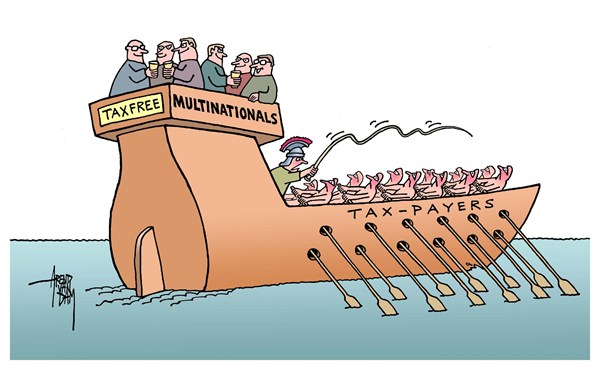
- To explore how financial information is used to make decisions.
- To explore good practice in spending, saving and borrowing and with a professional.
- Can describe different types of income and tax
- Can describe the ways that taxes are used by the Government.
Introduction to tax
The Government needs to raise funds to pay for public services (eg healthcare, police, nurses, schools) and infrastructure (eg roads, national parks). The main way in which they raise these funds is through taxes. In NZ, just under $100 billion is collected each year.
The main types of tax are:
1. Income Tax (PAYE)
Pay As You Earn (PAYE) is deducted from wages and salaries, before you receive the money. It is a 'Progressive Tax', meaning that if you earn higher income, you pay a higher percentage of your income in tax. We'll discuss the table below, but in simple terms it shows that:
- if you earn $14,000 you pay 10.5% ($1,470). I
- if you earn $14,100 you pay 10.5% on the first $14,000 and 17.5% on the extra $100; that's tax of $1,470 plus $17.50 which totals $1,487.50.
Activity: Calculate the income tax that you would pay if you earned $50,000 pa. The table below will help you.
2. Goods & Services Tax (GST)
Most goods and services that are purchased incur GST at 15%, which is added on to the basic cost of the products (eg if you buy a shirt for $115 in the shop, $100 is for the shirt and $15 is tax that the shop keeper passes on to the Government).
3. Company Tax
Companies pay 28% of net profits as tax. This is a flat rate - large and small profits are all taxed at the same 28%.Activity
1. In small groups, try to explain the 'multinational' cartoon above. Multinationals are companies that operate in several countries.
2. Discuss what might be disadvantages of large multinationals operating in NZ.
3. Discuss any benefits that companies like Google and Facebook bring to NZ
Here are some interesting resources on this topic:
- https://www.nzherald.co.nz/business/news/article.cfm?c_id=3&objectid=11607336
- https://www.beehive.govt.nz/release/multinationals-tax-legislation-introducedIRD numbers and deductions
The Inland Revenue Department issues you a IRD number when you start work - if you ask for one. It's important because they charge a very high 'default' tax rate if you do not have a number. You also need a IRD number if you earn interest or have a KiwiSaver account.
Deductions are made from your income for a range of things. Some are included in the PAYE income tax calculation (eg Accident Compensation or ACC, and student loan repayments). ACC is similar to insurance and pays for health care following accidents that New Zealanders have. Student loans do not have to be repaid until you start working. Your repayments are 12% of any income over $19,136 pa. Other deductions are pension contributions, like KiwiSaver. -
Learning Intentions
- To explore consumer spending and saving behaviours
- To explore how businesses use our emotions and values to encourage increased spending
- Able to explain consumer and business behaviours regarding spending and saving
- Can share examples of how our money decisions may be influenced and not always be conscious.
The psychology of money
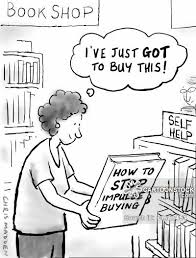
This area of learning will be led by you. Your challenge is to investigate an area of interest within psychology that relates to spending, saving and the actions of consumers and companies.
Values and beliefs
Your use of money (what you spend it on and how much you spend) says a lot about your values, beliefs and what you think is important in life. Things that you may think are important are: caring for the whole community, looking your best, perceived social status (impressing friends and neighbours), education, looking after yourself and not others, fun and living for the moment, travel, family, friends, etc.
Things that you might like to investigate in this area are: what do your, and your family's, use of money say about you? How does your family differ from others in NZ (eg how much does the average household donate to charity or spend on food or restaurants or savings each year )?
Emotions and money
Advertisers are experts at "pressing our buttons" and appealing to our emotions. Often, we don't even think about what's happening and change our behaviour automatically (and spending our money accordingly).
Things that you might like to investigate are: What emotions are specific adverts on TV, online or in magazines trying to evoke? How effective are their attempts? Which types of company appeal to our emotions of fear, desire to be loved/recognised/respected, loneliness, sadness, anger, shame, not belonging, etc?
Impulse buying
Impulse buying is unplanned and on the spur of the moment. Supermarkets are good at encouraging us to walk out with many more items than we planned to buy. They do this with large trolleys, discounts and Point of Sale material, positioning of items at isle-ends, free tastings, lots of food and entertainment in malls to keep you there longer, etc. Sometimes, people get home and soon reallise that they don't need or want what they have purchased! This especially happens when on holiday. It can lead to people feeling guilty or getting into financial difficulty. Having a shopping list and sticking to it has been shown to stop impulse buying!
Things that you might like to investigate are: Research real examples of 'tricks' (strategies) used to encourage impulse buying. Ask other students what they or their family have purchased in this way. Why might people buy things that they don't need?
Spaving
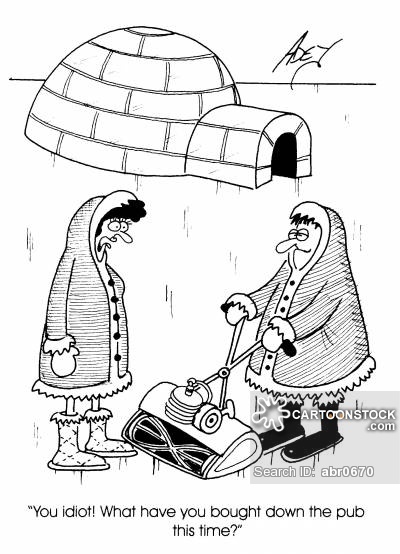
Spaving is spending to save, which means that you buy something because it's discounted and so think that you are getting a product for a bargain. The problem is that you may not have been going to buy the item in the first place and so, really, you could think of the discounted amount paid as being spending that you should not have made! This is different to reallising that you really need an item and consciously going out to research and buy the best deal.
Things to investigate: Research 'discounts' - the law about them, how effective they are, examples of unusual product discounts, etc.
Retail therapy
You know what this is - sopping to make yourself feel better! People say "I just needed cheering up, I deserve it, you only live once, it's ok just this once, etc".
You could investigate: what is meant by consumerism? Why George Bush said that the most patriotic thing Americans could do after '9/11' was to go buy things at the shops! What did people do to 'cheer themselves' before consumerism and shopping mall culture. Why might 'retail therapy' be problematic for some people?
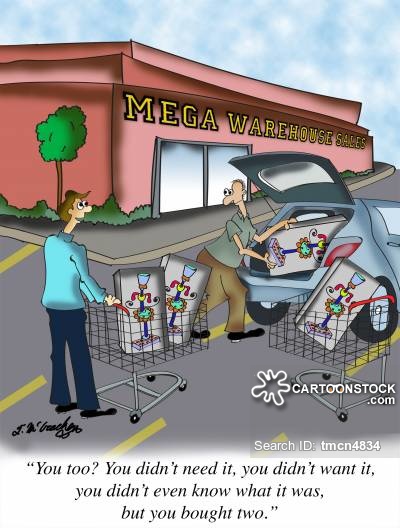 Avoiding the pitfalls!
Avoiding the pitfalls!Earning money is not easy - your time and skills are valuable. Looking after your money and being careful how you use this 'limited resource' is important. You could: Pay yourself first (by saving eg Kiwisaver), Be aware and thoughtful about what you buy (do I need it, can I afford it, why am I really buying it), Avoid watching adverts!, Budget and record spending, Be aware of habits that you have formed that have you spend without thinking, etc
You could investigate: budgeting advice websites, compare how much you save each week with other students.
Kiwis' spending and saving habits: https://www.westpac.co.nz/kiwis-spending-and-savings-habits-revealed
Activity
On Google Classroom, there are links to episodes of Nigel Latta's TV series "Mind over Money". In small groups, watch a 20 minute episode and summarise the main points in the document provided. This enables others, who do not watch the episode to learn from it. The link is below:
Having self control is the secret to becoming wealthy - Here's a Stuff article that explains this:
Mind over Money episodes link https://www.tvnz.co.nz/shows/mind-over-money/episodes/s1-e1
Guest presenters from the TSB Bank
Here's the slide presentation for the visit (click it to open). Your preparation beforehand is to think of questions that you want answered. -
Learning Intentions

- To explore how financial information is used to make decisions.
- To explore how businesses record financial information.
- To experience running a business as a team in a simulation scenario
- Able to record transactions in a Cash Flow Statement, Budget and Statement of Affairs
- Have run a simulated business as a team.
Financial Statements - Budgets
(and Statements of Affairs next week)
A budget is an estimate of your future income and expenses. It enables you to make decisions, such as: how much can I save each month? Can I afford to go on holiday in July?
A balanced budget has income equal to spending (hopefully where spending includes money saved or invested). If your finances go into 'the red', this means that you have spent more than you have earned and so have not enough assets to repay what you owe (the opposite is called 'in the black').
Types of expenditure
If you need to reduce your spending in order to balance your budget, you will reduce non-essential expenditure (eg trips to the cinema, treats, holidays) before reducing essential expenditure (eg rent, groceries, petrol).
There are are other ways to categorise spending. Fixed expenditure is the same amount for a period of time (eg rent, loan repayments). Variable expenditure increases and decreases as you use more or less of the good or service (eg entertainment, clothing purchases). Semi-variable expenditure has a fixed part and a variable part (eg electricity, in which you pay a 'standing charge' for maintenance & cables and which does not change, and a usage charge, which is based on how much electricity you've used that month).
Depreciation
A budget needs to have enough surplus to allow for depreciation, which is an estimate of how much value your assets (eg cars, furniture) have lost each year. Although depreciation is not cash being paid and so is not usually included in a budget, it is the value of assets being used up (and eventually needing to be replaced) and so needs to be considered when looking at the final surplus. If you don't put enough away for depreciation, there won't be enough savings to replace the asset at the end of its life.Converting figures
It's useful to remember that there are:
12 months in a year; 52 weeks in a year; 2 weeks in a fortnight; 26 fortnight in a year.Comparing budgeted and actual figures
At the end of the month, you should compare your estimates with what you actually received and spent. If you've overspent, this is bad news, as your surplus will be less or your deficit will be larger than expected. The difference between budgeted and actual figures is called the variance. This can be a negative figure if it makes your surplus less, or a positive figure if it makes your surplus larger. -
Learning Intentions
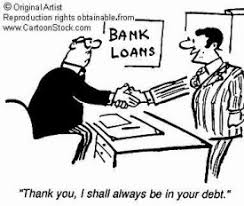
- To explore how businesses record financial information.
- To experience running a business as a team in a simulation scenario
- Able to record transactions in a Statement of Affairs
- Have run a simulated business as a team.
Statements of Affairs
A Statement of Affairs shows the assets, liabilities and net worth of an individual or household at a moment in time.
Assets are owned items that provide some benefit and are controlled by you (eg kitchen table, family car).
Liabilities are amounts that you owe others and have to repay (eg mortgage, overdraft).
Net Worth is the value of what you own less the value of what you owe others. You would hope that Net Worth would increase over time!
When applying for a loan or credit card, banks will ask for the information in a Statement of Affairs.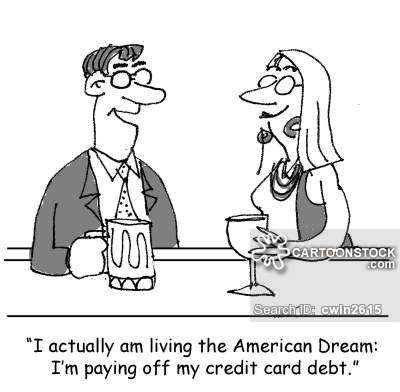
Have a go at the questions in Google Classroom on Statements of Affairs.Extension:
Look up Income and tax rates in other countries. Find out what is meant by a tax haven and find examples of these - find them on Google Maps.
Find out what's the difference between a debit card and a credit card?
Research what interest rate you would pay on a mortgage and would receive on savings with different banks.
How does this compare with the growth rate of other investments, such as shares? - To explore how businesses record financial information.
-
Learning Intentions
- To link our class learning to the 'real world', by involving community experts from a high street bank.
- To explore good practice in spending, saving and borrowing and with a professional.
- Able to describe connections between 'class theory' and best practice in the 'real world'.
- Able to describe how we might change our behaviour to benefit financially in the future.
More on money
The Reserve Bank of NZ is different to the high street banks. It is responsible for managing inflation; producing currency; and regulating banks, finance companies and insurers.Watch this video clip about the RBNZ.
Have a look at the answers to these frequently asked questions.
http://www.rbnzmuseum.govt.nz/learningcentre/Questions.aspx
-
https://youtu.be/eBD5hQVwi2o?list=PL63510640E8F9721AOverview Micro
Basic Macro Overview
Overview Macro
Brief intro
Supply & Demand

